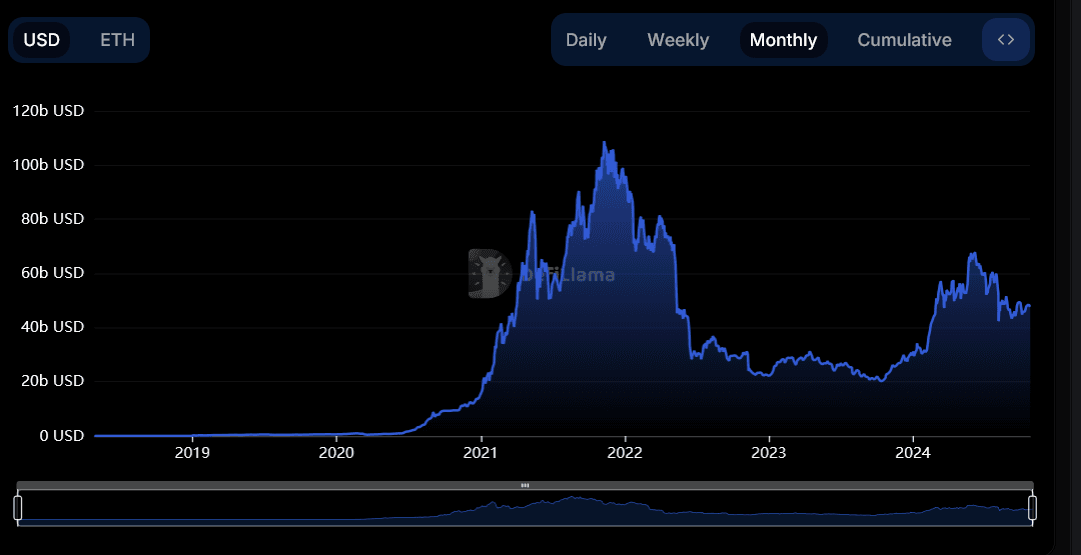Ethereum has been on a downward trend for the past few days, struggling to stay above the $2,700 level. After failing to break past this key resistance, the price continues to drop, leaving investors wondering if more declines are on the way. In this Ethereum price prediction article, we’ll take a closer look at what’s driving Ethereum’s recent performance and what could happen next.
How has the Ethereum Price Moved Recently?
ETH/USD Daily Chart- TradingView
Ethereum is currently priced at $2,547.76, with a 24-hour trading volume of $26.99 billion, a market capitalization of $306.69 billion, and a market dominance of 13.10%. Over the last 24 hours, Ethereum’s value has dropped by 1.70%.
Ethereum’s all-time high was reached on November 10, 2021, when it traded at $4,867.17. Its lowest price was recorded on October 21, 2015, at just $0.42. Since hitting its peak, the lowest point Ethereum has fallen to is $897.01, while its highest rebound since then reached $4,094.18. Currently, the market sentiment surrounding Ethereum is bearish, and the Fear & Greed Index sits at 69, indicating a “Greed” sentiment among investors.
The circulating supply of Ethereum stands at 120.38 million ETH, with a yearly supply inflation rate of 0.09%, meaning an additional 111,486 ETH were created in the past year.
Why is Ethereum Price Down?

Ethereum Total value Locked- DefiLlama
Ethereum’s price decline can be attributed to a combination of factors that have created uncertainty and weakened investor sentiment. On October 23, reports surfaced that the Ethereum Foundation sold another batch of ETH tokens, a move that typically signals caution to the market.
Such actions often cause concerns among investors, as it implies that insiders may believe the current price is high or that they are hedging against potential future declines. This news adds to the ongoing struggles Ethereum has faced, including an underwhelming performance of multiple spot ETFs in the U.S., which had been anticipated to boost interest and demand for ETH but failed to deliver the expected market impact.
Another key factor contributing to Ethereum’s price dip is the decline in its Total Value Locked (TVL) across decentralized finance (DeFi) protocols. Since mid-June, Ethereum’s TVL has dropped by over 2% in the past 30 days, underperforming other top layer-1 protocols like Solana, which experienced a 22% increase in TVL during the same period.
The shrinking TVL indicates reduced activity and capital flowing into the Ethereum network, signaling a potential loss of interest among developers and users in its DeFi ecosystem. This drop from a year-to-date peak of $66 billion to the current $48 billion underscores the challenges Ethereum faces in maintaining its dominance in the DeFi space.
Looking ahead, Ethereum’s near-term price movements may remain under pressure unless significant catalysts, such as major technical upgrades or shifts in market sentiment, emerge. However, there are ambitious goals within Ethereum’s roadmap that could change its trajectory in the long term.
Co-founder Vitalik Buterin has recently reiterated Ethereum’s plans to achieve 1,000 transactions per second through the “Surge” phase of its development. If Ethereum can successfully implement these upgrades and increase scalability, it could restore investor confidence and reignite demand. In the short term, however, Ethereum may continue to face bearish sentiment, especially if broader market conditions remain uncertain and competitors like Solana continue to gain momentum in the DeFi space.
Ethereum Price Prediction: How high can the Ethereum Price Go?
Ethereum’s potential for future price growth hinges on a mix of positive and challenging factors. Over the last year, Ethereum has seen a price increase of 43%, reflecting its resilience and steady demand in the broader cryptocurrency market.
Additionally, Ethereum benefits from high liquidity, given its large market cap and strong presence in decentralized finance (DeFi) and smart contract platforms. Its relatively low yearly inflation rate of 0.09%, meaning only a small number of new tokens are being created, helps prevent significant dilution of existing holdings, supporting long-term price stability.
However, Ethereum has underperformed compared to 59% of the top 100 crypto assets over the same period, and it has notably lagged behind Bitcoin. This underperformance indicates that while Ethereum has shown steady growth, other assets have attracted more significant attention and capital, leading to stronger gains.
Furthermore, Ethereum is currently trading below its 200-day simple moving average (SMA), a technical indicator that typically signals bearish market sentiment in the near term. Only 14 out of the last 30 days have been “green,” suggesting that Ethereum has struggled to maintain upward momentum recently.
Despite these headwinds, Ethereum’s roadmap offers substantial upside potential in the long term. The ambitious goal of reaching 1,000 transactions per second as part of the “Surge” phase could significantly enhance Ethereum’s scalability, attracting more users and developers to its platform.
If these upgrades are successfully implemented, Ethereum could regain its competitive edge, positioning it as a leading blockchain for DeFi, NFTs, and decentralized applications.
Looking at the potential for price growth, if Ethereum can break above its current technical resistance, including its 200-day SMA, and if broader market sentiment turns bullish, Ethereum could see significant upward movement. In the short to medium term, a rally towards its all-time high of $4,867.17 is possible, particularly if market conditions improve and Ethereum’s upgrades bolster its functionality.
However, any sustained rally would require a shift in investor sentiment and stronger performance relative to competitors like Bitcoin. In summary, while Ethereum has the potential to move significantly higher, it will need to overcome current market challenges and prove the value of its upcoming technical advancements to unlock that growth.
Read the full article here

